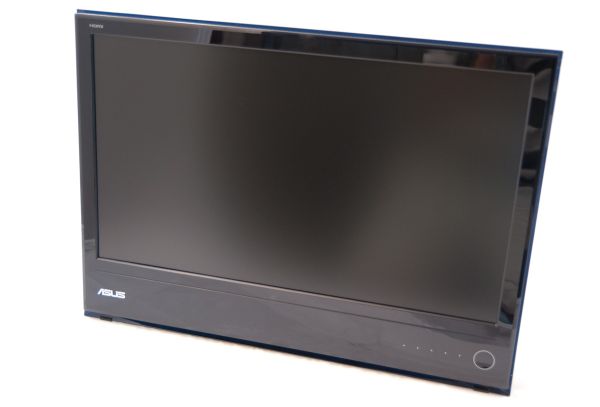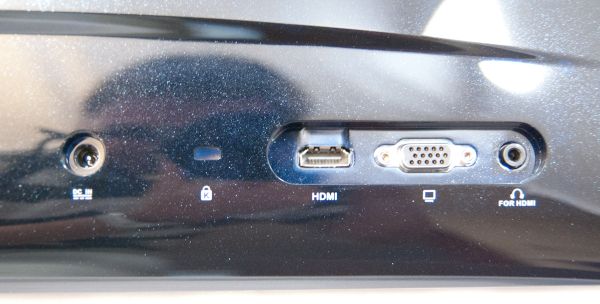ASUS MS238H Review - Slim and Affordable
by Brian Klug on December 24, 2010 1:47 AM ESTIntroduction
So I have a confession to make. The past few months I've been incredibly preoccupied with smartphones, so much so that the ASUS MS238H has been sitting on my desk for a very long time. The data's been largely taken, the display calibrated, but for whatever reason the review has endlessly been on my back burner - I'm sorry ASUS. The upside of this situation, however, is that I've spent a long time using the ASUS MS238 and feel like I know it inside and out, and it's a slim value performer.
Let's start with the specifications. The MS238H is a 23-inch LED-backlit, TN-panel packing display with an extremely slim profile, and even slimmer budget price tag. We're used to primarily covering the high-end side of the market with IPS displays, which the MS238H definitely isn't, but that isn't to say this segment isn't worth taking a look at. The MS238H is also of the 1080P, (and thus 16:9 aspect ratio) variety, a rather disturbing trend that's all but eliminated the 1920x1200, 16:10 market. The specs are what they are, and you can find them in the table below:
| ASUS MS238H - Specifications | |||
| Property | Quoted Specification | ||
| Video Inputs | HDMI, D-Sub (DVI-D through HDMI connector) | ||
| Audio Output | 3.5mm Mini-jack for HDMI Audio | ||
| Panel Type | TN with LED Backlight | ||
| Pixel Pitch | 0.265 mm | ||
| Colors | 16.7 Million (24 BPP) | ||
| Brightness | 250 nits | ||
| Contrast Ratio | 1,000:1, or 100,000:1 (dynamic) | ||
| Response Time | 2ms (g2g) | ||
| Viewable Size | 23" (54.8 cm) diagonal | ||
| Resolution | 1920x1080 (1080P) | ||
| Viewing Angle | 170 degrees horizontal, 160 degrees vertical | ||
| Power Consumption (operation) | <33 watts typical | ||
| Power Consumption (standby) | <1 watt typical | ||
| Screen Treatment | Matte | ||
| Height-Adjustable | No | ||
| Tilt | Yes: 10 degrees - 20 degrees | ||
| Pivot | No | ||
| Swivel | No | ||
| VESA Wall Mounting | No | ||
| Dimensions w/ Base (WxHxD) | 21.9" (556 mm) x 15.9" (403.8 mm) x 5.9" (150.9 mm) | ||
| Weight w/o Stand | 8.4 lbs (3.8 kg) | ||
| Additional Features | 16.5mm thickness, kensington lock | ||
| Limited Warranty | 3 years - repair or replacement | ||
| Accessories | DVI-D to HDMI cable, VGA D-Sub cable, External Power Supply | ||
| Price | MS238H MSRP: $229.99, Amazon: $169.99 | ||
It should be pretty obvious that this display is really oriented at budget-conscious shoppers, or gamers looking for a display small and light enough to augment a notebook or portable LAN party rig. In fact, after carrying the thing to and from rooms to photograph many a time (as inevitably happens with all other displays up for review), that's really what I'm left thinking the MS238H is most suited for. It's light, it's thin, and has a headphone jack for HDMI audio, which makes it suited for periodically connecting up to a console or two.
Inputs are the only real concern on the MS238H - the two options are HDMI or D-SUB for VGA. It'd be nice to see two HDMI ports, or even HDMI and DVI-D, instead of D-SUB. What the MS238H does have going for it is that WLED backlighting, being a power-sipper, and again thin profile.












38 Comments
View All Comments
Brian Klug - Friday, December 24, 2010 - link
Oops, fixed! We switched graphing engines and two entries always had their series reversed, didn't catch that one.-Brian
Spacecomber - Friday, December 24, 2010 - link
Numbers are reversed.dingetje - Friday, December 24, 2010 - link
asus can shove their 16:9 displays where the sun don't shine :)bring back 16:10
chrnochime - Friday, December 24, 2010 - link
And you can do the same with your oh- so-very-useful comment :Djah1subs - Friday, December 24, 2010 - link
ONE or TWO YEARS AGO, I remember reading in Digitimes that panel makers were going to be transitioning from 16:10 to 16:9 because they could cut out more panels per "substrate" or "wafer" or whatever it is called.So yes, it is about manufacturing cost. I just saw an article on Digitimes yesterday that some manufacturers will be starting to manufacture, or plan to manufacture, even more extreme aspect ratios, e.g. 21:9.
Conclusion, IMHO, if you see a 16:10 that you like today, buy it. There might not be a next generation version of it.
Personally, I am starting to be interested in 16:9 27" LED backlit monitors. The first ones have recently come on the market. I make this statement based on using Newegg's PowerSearch function. Until recently, 24" were listed but not 27". These monitors are the smallest size that will allow me to display images of 2 views of 8.5x11 paper at 100% scale in portrait mode side by side. Of course, I want LED for reduced power requirements and improved contrast.
Sundae - Friday, December 24, 2010 - link
Hey any chance of you guys doing a review on the Samsung P2370? I ask because I was strongly considering this monitor but heard the P2370 was a better choice. It even came with a microfiber cloth!poohbear - Saturday, December 25, 2010 - link
erm how many of the andandtech reviews start with "so i have a confession to make." lol scrolling down the nvidia tegra 2 article starts the same. just a get a priest on the andandtech staff already to absolve u of your hardware lusting sins.Hrel - Saturday, December 25, 2010 - link
I really hate how it seems like everyone at anadtech is against 1080p. That's the industry standard, that's where things are going, quite fighting it and get with the times. 16:9 is a great divide between height and width. Also, all modern content is made for 16:9, NOT 16:10. Black bars are FUCKING ANNOYING!Second point, all movies that are filmed in anything wider than 16:9 are stupid and I end up cropping them in Power Director. I long for the day when ALL media content is just standardized at 16:9 with no variation at all. That way everything would fit the screen and nothing would need to be formatted there by wasting valuable screen real estate.
Hrel - Saturday, December 25, 2010 - link
I should add that every monitor should have a base that allows for it to be spun so it's wider than it is tall. I do understand there are times when massive vertical real estate is nice. I use a 37" TV as my monitor so I have no issues. But on a smaller screen it'd be nice to be able to spin it and have the screen know that like smart phones do.wagoo - Sunday, December 26, 2010 - link
You have no issues with vertical real estate because you use a 37" TV as your monitor? Um.. it'll still have the same 1080 pixels available as a 22" 1080p monitor.. or hey, slightly more than my ancient 17" 1280x1024 LCD.A lot of the TN panels if you look at them from a vertical orientation you'll get a headache unfortunately, as each eye will be seeing different colours.
I prefer 16:10 personally, however I think that's mainly due to 1080p just being too small height-wise. Maybe I'd like the 2560x1440 Dell U2711.